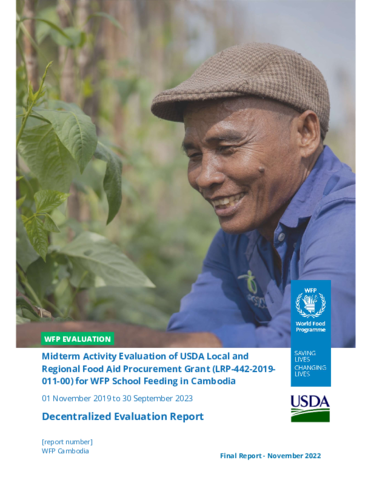
This report presents the findings from the endline evaluation of the United States Department of Agriculture’s (USDA) Local and Regional Food Aid Procurement (LRP) programme for World Food Programme (WFP) School Feeding activities in Cambodia, covering the period 01 November 2019 to 30 September 2023 (with a no-cost extension agreed through September 2024). The evaluation included both accountability and learning components with a prioritization of learning, and covered five evaluation criteria: relevance, effectiveness, efficiency, impact, and sustainability. The latter focused on the handover and transition process to the national home-grown school feeding programme (NHGSFP).
The LRP was a pilot project to support strengthening national and local systems for local procurement of food commodities for schools within the larger Home Grown School Feeding framework. The LRP focused on enhancing local procurement processes for school feeding programmes by transitioning from imported in-kind food assistance to locally-purchased commodities. The project aimed to build local procurement capacities within schools and at sub-national levels, promote women's participation in procurement processes, and strengthen linkages between procurement and local agricultural production, particularly involving smallholder farmers. The project also addressed challenges related to market aggregation for suppliers, the integration of local procurement with agricultural development, and the sustainability of procurement systems after schools had transitioned from WFP support. The suppliers, farmers, and school personnel are the effective beneficiaries of the project interventions although ultimately these interventions are intended to cascade down to affect the quality of the meals eaten by school children and contribute to associated health and education outcomes for children
Key findings were as follows:
Relevance. The LRP is strategically relevant to the needs of Government and local stakeholders and provided an opportunity to support the transition of schools from an imported in-kind school meal programming modality to the government supported and managed NHGSF modality relying on locally purchased commodities
Effectiveness. Achievement rates are highest for those indicators targeting local school capacities for procurement processes. The overall coverage and quality of the cash transfer process has been successful with the schools and procurement related indicators having met or exceeded targets. The components related to technical assistance to smallholders has started but is less advanced and less well integrated with school procurement opportunities. More than 60 percent of the suppliers and farmers were women; and women experienced larger gains then men according to the farmer and supplier surveys. However, these gains are not visible within the existing results framework which does not require disaggregated reporting on gender.
Efficiency. Overall cost efficiency for project implementation is in alignment with the project plan and indicates relatively low overhead costs due to the emphasis on capacity strengthening within the LRP.
Impact. The national level commitments and mechanisms are in place to support schools in local procurement after handover of schools. The school-based side of the LRP procurement have been effectively established. There are positive examples of women’s empowerment gains from participation in the LRP as suppliers and farmers (or school cooks), even though these are not systematically tracked in the existing LRP results frameworks. There has been less impact in linking smallholder producers to the school procurement - suppliers will purchase from smallholders, but this is not systematic. An additional constraint is that for the suppliers, the schools do not, by themselves, represent a sufficient market for suppliers to maintain themselves.
Sustainability. The handover and transition process has progressed well since the midterm evaluation, and stakeholders expressed confidence that school-based local procurement processes will continue, even if the NHGSFP connection to local agricultural development is less strong than originally envisioned in the project. The ending of the project cycle at this time has presented unfortunate consequences for ongoing processes that have been established, but which require further fine-tuning and adjustments to be sustained including the formalization of the agricultural stakeholders in the technical assistance; modeling alternative approaches to contracting, aggregation, and profitability; the procedures and flexibility of setting the target prices for commodities; the linkages with agricultural cooperatives for the procurement; and further strengthening food sourcing and safety considerations.
Key recommendations from the evaluation included:
- Conduct a systematic review to determine the areas for ongoing technical assistance that WFP can provide to the Government in the post-transition phase.
- Conduct an assessment and mapping of the types of schools (size, distance from market, existing infrastructure, vulnerability population) best suited for the application of the standard approach to NHGSFP procurement and school meals provision.
- Support the development of an array of pilots to assess the feasibility of multiple food delivery models within the NHGSFP that might better fit the contexts of different types of schools.
- Support the development of an array of pilots to assess the feasibility of multiple procurement and contracting models.
- Consider a mechanism to systematically identify, assess and provide technical assistance to those few schools that were transitioned within designated districts without being fully ready.
- Integrate and make visible the LRP contributions to gender equality, by improving gender sensitivity in the results frameworks for the next programme cycle of school feeding (even if it does not include an LRP project itself
